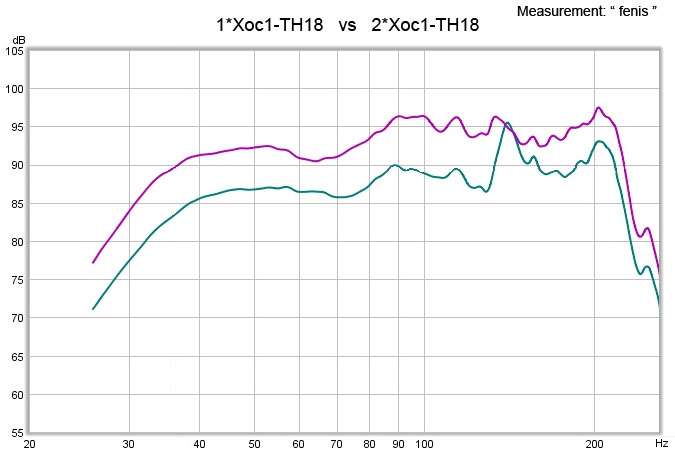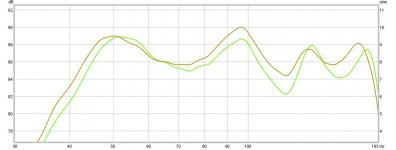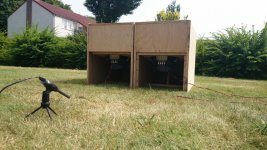Yes, i am playing with the Reflection element right now (but not in a subwoofer design.)In AkAbak this is easy to do by turning on corner boundary conditions "Bottom-Corner" switch for reflection. Set distance from walls and floor. It makes a big difference in gain in low frequencies and your finding that it has no effect below 300Hz is incorrect. It is not the same as setting 1/8-pi space as it is frequency dependent gain.
Re 300Hz: I think it was a box in free vs 1/8th space (from 90 to 99dB/W/m) and actual horn loading (90 to 110dB/W/m) Anyway, regarding the optimal entry point in conical horns/corners, I regard Mr Danley as the authority so hopefully he will chime in. For me I remembered this offset-horn trick as a way to use the distructive interference from the offset horn/corner as an extra filter to remove possible higher harmonics from a sub by placing it at an appropriate distance from the corner.
But I feel I'm veering off-topic so I'll rest on this for now.
Anyway, thanks for the tips on AkAbak, I'll keep it in mind!
Sorry to bring back this old topic. Seems the sound silenced on the 'bubble' and this topic got 'buried into the ground' for infinity.
It was an interesting read, all theories on the BC. But the last page was kinda anti climax.
It was an interesting read, all theories on the BC. But the last page was kinda anti climax.
It would be useful if someone with a stack of 4 TH's can do an experiment with measuring bass extension for one vs four TH's stacked together in 2x2 (with mouths all adjacent to one another) to see if there is a deepening of bass. Otherwise we are just at an impasse regarding whether or not the bubble theory holds or has been popped.
I could try and design a FLH for my Beyma SM110's (10") I have sitting around. I have four of them. BUT I am thinking the Beyma's would be better for 80hz and up.
That's weird, because it suggests that the LF corner actually goes HIGHER with more THs...
Danley (actually Beaver) measured 1 vs 4 at some point. The following is copied and pasted from here - http://www.diyaudio.com/forums/subwoofers/170771-single-sheet-th-challenge-133.html#post2854360
TB46 pointed out there may be problems with this measurement, but it seems to show the low knee pretty clearly at least.
TB46 pointed out there may be problems with this measurement, but it seems to show the low knee pretty clearly at least.
I have also worked out Ivan Beaver's measurements of the DSL-TH115 in stacks to an higher resolution to get a more precise picture.
First the original:

Second with +12dB for 1 TH115 and +6dB for dual stack:

Last edited:
Danley (actually Beaver) measured 1 vs 4 at some point. The following is copied and pasted from here - http://www.diyaudio.com/forums/subwoofers/170771-single-sheet-th-challenge-133.html#post2854360
That looks a little better, though the "red" graph suggests that the mic was clipping at that point. Looks like the output around 40 Hz smoothed out quite a bit.
Yeah, TB46 mentioned compression in the next post after the one I quoted, and I just editted my post to reflect that. It does seem to show the low knee frequency ok though. Ok enough to see that the low knee doesn't move down in frequency a couple hz like stacked front loaded horns would.
Last edited:
Yeah, TB46 mentioned compression in the next post after the one I quoted, and I just editted my post to reflect that. It does seem to show the low knee frequency ok though. Ok enough to see that the low knee doesn't move down in frequency a couple hz like stacked front loaded horns would.
The graphs aren't that well lined up either. The blue and brown graphs should be slightly lower, to match the output on the red graph between 50 Hz and 70 Hz. Once you do that, the result suggests an extra 3dB @ 40 Hz and a smooth rolloff below that.
To me, that shows that there IS some gain in output at low frequencies when stacking THs.
Hi Brian,
I think it is time for you to measure a real stack... : -)
The gain in the low end is the result of an increased directivity
Cheers,
Djim
I think it is time for you to measure a real stack... : -)
The gain in the low end is the result of an increased directivity
Cheers,
Djim
Last edited:
Djim stated what he did to the graph traces, he added 12 db to the single cab trace and 6 db to the dual cab trace. He didn't match them up so 50 - 70 hz lined up.
I can't even remember what this thread was about but I don't think anyone said that stacking THs didn't give some gain at low frequencies. The more common question is whether they will gain extension to lower frequencies when stacked. It would be nice to see impedance too, to see if tuning changed at all. It's hard to tell from this picture. I'm guessing not much. It might change a tiny bit due to increased frontal boundary loading alone (directivity), but probably not much.
I can't even remember what this thread was about but I don't think anyone said that stacking THs didn't give some gain at low frequencies. The more common question is whether they will gain extension to lower frequencies when stacked. It would be nice to see impedance too, to see if tuning changed at all. It's hard to tell from this picture. I'm guessing not much. It might change a tiny bit due to increased frontal boundary loading alone (directivity), but probably not much.
Errata:
The graph I posted is a FLH, the EAW KF940 in an anechoic chamber, not a tapped horn.
"The KF940 is engineerd to be used in arrays of four or more to
produce extremely high output sub bass response to the very
bottom of the audible spectrum."
Is there a 'bubble'?
The graph I posted is a FLH, the EAW KF940 in an anechoic chamber, not a tapped horn.
"The KF940 is engineerd to be used in arrays of four or more to
produce extremely high output sub bass response to the very
bottom of the audible spectrum."
Is there a 'bubble'?
To my knowlegde stacking subs will smoothen the band and add more db. I have no experience with a TH type of sub but I do with stacking multiple FLH's that it also smoothens the band a lot and got a big amount of extra db's output on the same amount of input voltage. Lets say 4x40v max to 4x30v max for same ouput level.
What I do with a stack of 4 or more (Depends on situation) I then can lower the input voltage and lower the HP from 40Hz to 30Hz. So i basically shifting the Xmax position based on input voltage. It also flattens some peaks at the 100Hz > 120Hz zone.
Going back to the BC sub it outputs four 'subs' into a box with a hole. Seems to me the 'bubble' is like a cabin gain (car audio term). so creating a pressurized zone causing a raise in db/octave.
What I do with a stack of 4 or more (Depends on situation) I then can lower the input voltage and lower the HP from 40Hz to 30Hz. So i basically shifting the Xmax position based on input voltage. It also flattens some peaks at the 100Hz > 120Hz zone.
Going back to the BC sub it outputs four 'subs' into a box with a hole. Seems to me the 'bubble' is like a cabin gain (car audio term). so creating a pressurized zone causing a raise in db/octave.
Hi all,
A lot has to do with the way you configure. This is an example of r23d where he set them up on their side but on top of each other.
Cheers,
Djim


A lot has to do with the way you configure. This is an example of r23d where he set them up on their side but on top of each other.
Cheers,
Djim


Hi all,
Another example of one/two Xoc1-TH18's standing up against a wall. Probably measured within the 'bubble'. Not sure why the results are so low in SPL but the measurements look consistent.


Another example of one/two Xoc1-TH18's standing up against a wall. Probably measured within the 'bubble'. Not sure why the results are so low in SPL but the measurements look consistent.


Hi USRFobiwan,
"...Looks like 2.83v measurement..."
Those values (upper curves) would be ~0.6 to 0.65 Vac using a PD1850 in Hornresp @ 2.0xPi. Could also be just offset.
Regards,
"...Looks like 2.83v measurement..."
Those values (upper curves) would be ~0.6 to 0.65 Vac using a PD1850 in Hornresp @ 2.0xPi. Could also be just offset.
Regards,
Hi guys.
Thanks for all the data. I asked and did not expect so many people to provide real data.
Looks like a mixed bag. The BC415 is probably closer to 4x FLH's than a tapped horn.
Thanks for all the data. I asked and did not expect so many people to provide real data.
Looks like a mixed bag. The BC415 is probably closer to 4x FLH's than a tapped horn.
- Home
- Loudspeakers
- Subwoofers
- Danley BC-subs reverse engineered


